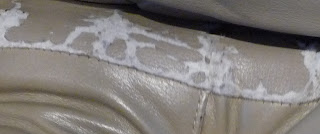Look at this picture...
What you see is a leather seat top that is sewn to a vinyl side panel. The vinyl side panel has broken down. Once vinyl gets to this state of deterioration it cannot be effectively repaired. Note that on the leather side of the seam, everything is normal. This is a clear example of how quality top grain leather will outlast vinyl. All of the stress of weight baring is on the leather panel. The side panel is simply flexing as a person sits on the seat cushion, yet the deterioration of the vinyl is plainly obvious. This is a fairly common manufacturing process to intended reduce cost for the manufacturer. It is most commonly found on motion furniture (recliners).
Here's a close up of the same picture.
Note that the erosion of the vinyl is complete along the entire length of the seam.
Why does this happen?
The answer lies in the attributes of both materials. Leather is organic. It is infused with oils at the tannery to impart suppleness. Leather breathes. As such it looses its moisture (oils) through evaporation. Vinyl is a synthetic byproduct of the petrochemical industry. Polyvinyl Chloride (PVC) is typically a solid. Think of the plastic garden pipe used in home irrigation system. PVC pellets are heated and mixed with an oil then this mixture flows over a cloth and when dry is now vinyl as found on furniture. The oil in vinyl is not molecularly bound to the vinyl molecule. Its free floating.
As leather looses its moisture through evaporation, to equalize that moisture loss, it wicks the oils from the vinyl side of the seam. Thus oils vacate the vinyl, as they are sucked into the leather. This loss of oil gradually reduces the vinyl to its original solid state and it slowly flakes away as shown in the picture. The thinner the vinyl, the quicker this will happen.
Once the vinyl coating of the cloth substrate disappears, it cannot be replaced through a repair. The only solution is to remove the offended panel and replace with new. To do that requires disassembly of the furniture which balloons the cost beyond reasonable.
This vinyl failure is one of the perils of a leather-vinyl combination. Most people are not aware that components of there furniture are vinyl. Generally the piece is sold as "leather furniture" when in fact it's part leather and part vinyl. When I see this condition I recommend that the client not invest further in the piece. It's time to get new furniture.
If you have leather and vinyl on the same piece of furniture, then to prevent this from becoming your problem, keep the leather moisturized. Properly and frequently apply leather conditioner (SG - 25 moisturizer) to ensure that the leather has no need to wick the oils from the vinyl.
Copyright 2010 Kevin Gillan


No comments:
Post a Comment